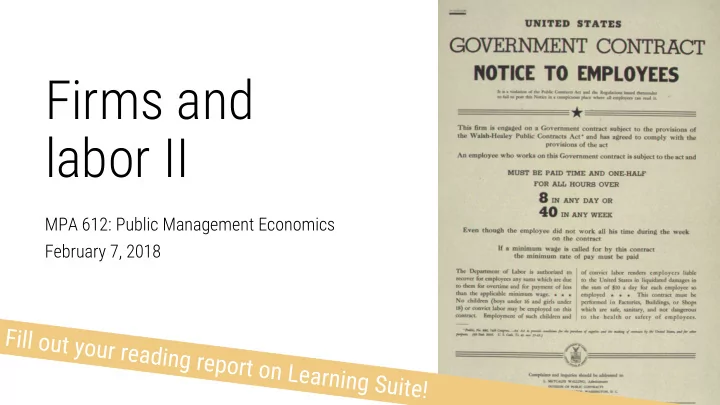

Firms and labor II MPA 612: Public Management Economics February 7, 2018 Fill out your reading report on Learning Suite!
Current events
Plan for today Asymmetric information Employees (continued) Labor discipline Outsourcing
Asymmetric information
Adverse selection Hidden knowledge Fix with screening Moral hazard Hidden action Fix with monitoring
Employees Asymmetric information and incomplete contracts
Optimal solution Marginal benefit = marginal cost
Effort Return Cost Marginal return Marginal cost 0 0 0 1 70 0 70 0 2 140 20 70 20 3 210 40 70 20 4 280 60 70 20 5 350 90 70 30 6 420 120 70 30 7 490 160 70 40 8 560 200 70 40 9 630 250 70 50 10 700 300 70 50
Labor contracts are inherently incomplete Tasks based on Tasks difficult to unknown future measure
But workers still work! Why? Norms Feelings of responsibility Calling Public service motivation Fear of being fired
Economic rents Payment or benefit received above and beyond what you would have received from your next best alternative
Employment rent = wage − reservation wage − disutility of effort = What Maria gets should she not lose her job today = What Maria gets should she lose her job today Rent per hour × Hourly wage expected lost = $ 12 hours of work Maria’s rent when employed Employment $10/hour × 1,540 rent per hour hours = $15,400 Disutility of an hour of Disutility of effort when employed effort = $2 Expected duration of 0 unemployment = 44 weeks 0 (1540 hours) Number of 35-hour weeks
= What Maria gets should she not lose her job today = What Maria gets should she lose her job today Hourly wage = $ 12 Employment Maria’s rent when employed rent per hour Unemployment benefit plus the disutility of effort = $8 Disutility of effort when employed $4/hour × 1,540 Unemployment benefit = $6 hours = $6,160 Reservation wage per hour What Maria receives in unemployment benefit during her period of unemployment 0 Expected duration of 0 unemployment = 44 weeks (1540 hours) Number of 35-hour weeks
Labor discipline How much should you work? How much should you pay people?
Why do owners pay people? Employers can’t directly measure effort So they take advantage of the fact that work is afraid of losing job and they increase the cost of job loss Large employment rent → large cost of job loss → worker works more to avoid getting fired
Employer chooses a wage If worker works hard enough, they keep job at that wage Worker chooses level of effort Worker considers costs of losing job if they don’t work hard enough Firm payoffs: profit = worker’s output − wage Worker payoffs: employment rent
Slope = MRT 1 Maximum possible effort Response curve Worker’s best response curve K when expected unemployment 0.8 Optimal effort for duration is 44 weeks Effort per hour each wage J 0.5 Feasible set Slope of feasible frontier = MRT 0 0 6 12 24 Reservation wage Hourly wage, $
Efficiency unit = unit of Lower Medium cost of effort 1 cost of effort effort per dollar = e/w 0.9 Higher cost of effort Cost per unit of B 0.7 A Effort per hour Slope = MRS effort = w/e 0.6 0.45 Isocost curves are like indifference curves for 0 10 13 20 0 employers Hourly wage, $
Minimum Lower cost of effort feasible (but infeasible) cost 1 MRS = MRT Worker’s best response curve Just like B 0.7 Effort per hour indifference A 0.5 MRS= MRT Higher cost of effort curves and budget lines C 0 0 12 10 Reservation Hourly wage, $ wage
Involuntary unemployment Necessary to keep employment rent high enough for workers to keep working 4.5–6%
Outsourcing When should government privatize stuff?
Why is the outsourcing or privatization of government goods so popular? How is outsourcing a principal-agent problem?
Is privatization of government services good? Good: lower cost Bad: lower quality Irrelevant: competition
Gist of the model Service provider can invest in quality or in cost reduction Cost reduction leads to worse quality
Gist of the model If provider is government, employee receives fraction of returns on investment If provider is private contractor, they have control over asset and incentive to improve quality *and* reduce costs
Gist of the model BUT incentive to reduce costs is too strong since private contractors ignore the adverse impact on quality
Conditions for contracting The bigger the adverse consequences of cost-cutting on quality, the stronger the case for in-house provision In-house provision should focus on quality and provide enough incentives for employees
Should governments outsource… Snowplows Garbage Mail Schools Healthcare Prisons Police Military
Recommend
More recommend